中国科技论文在线
http://www.paper.edu.cn
Tera-Hertz Wave Amplification vis
Relativistic Electrons Pumped by a Planar
Electrostatic System 1
Shi-Chang Zhang*
Institute of Photoelectronics
Southwest Jiaotong University
Chengdu, P. R. China610031
sczhang@home.swjtu.edu.cn
Abstract
A mechanism of Tera-Hertz wave amplification is proposed, where a planar
electrostatic pumps the kinetic energy of relativistic electrons to the wave. The planar
electrostatic system is formed by two parallel metallic plates, where the super-plate is
corrugated with sinusoidal ripples and connected to a negative voltage while the
sub-plate is smooth and grounded. The relativistic Doppler up-shift frequency and
gain of the wave are derived in detail.
1
I n t r o d u c t i o n
In the past years, the free-electron laser (FEL) has been widely investigated as a new kind of coherent
radiation sources 1-10. Compared to the ordinary lasers, it has an attractive peculiarity that the frequency
is tunable from microwave to x-ray, especially in the far-infrared range and x-ray 11, 12. Physically
speaking, a FEL is based on the coherent radiation simulated by relativistic free electrons in a
magneto-static system (referred to as the wiggler or undulator) in which the magnets are alternatively
arranged so as to let the magnetic field have a sinusoidal distribution. In this periodical magnetic field,
relativistic electrons move along approximately sinusoidal trajectories, and it is the periodic-varying
motion of the relativistic electrons that results in the electromagnetic emission.
After the pioneer operation of the first free-electron laser experiment at Stanford University 2, two other
kinds of proposed wigglers emerged, which were expected to play similar role as a magneto-static
wiggler does. One is refereed to as the electromagnetic-wave wiggler, where an external
electromagnetic wave is injected into the interaction range and its components with sinusoidal variation
in space and time govern the relativistic electrons 13. The other is the so-called electrostatic wiggler
either by using a ring-loaded waveguide where the rings are insulated from each other and alternatively
connected to a positive/negative voltage 14, or by utilizing a large potential drop of the electron beam to
the wall corrugated with ripples 15.
As was pointed out in Ref. [15], in fact, wave amplification in an electrostatic system with a rippled
cylindrical tube is by no means new. Previously, wave amplification was performed by utilizing the
1 Support by the China University-College PhD Science Foundation (No. 200806130012) and the NSFC (no.
60871023).
1�
中国科技论文在线
http://www.paper.edu.cn
slow-wave modes16-18, or non-relativistic electron beam19, 20, or space-charge waves15, 21, 22. Generally
speaking, a slow-wave structure is complicated; use of non-relativistic electron beam obstructs the
output power; and effect of the space-charge wave needs high-current electron beam. Perhaps due to
these restrictions, unfortunately, studies of wave amplification in an electrostatic system with
corrugated periodic ripples have been ceased since then on. Up to date main interest in the corrugated
periodic-ripples structure is concentrated on the application as Bragg reflectors to constructing high-Q
cavities for the cyclotron autoresonance maser (CARM) and free-electron laser oscillators23-41.
To the best of my knowledge, field distribution in an electrostatic system with corrugated
periodic-ripples boundary was not analytically derived before. Recently, analytical derivation
demonstrated that a planar electrostatic system with sinusoidal ripples can efficiently modulate
relativistic electrons just as a magnetostatic wiggler (or undulator) does in FEL42. Here the planar
electrostatic system is performed by two parallel metallic plates: the super-plate is corrugated with
sinusoidal ripples and connected to a negative voltage; the sub-plate is smooth and grounded. Unlike
the works before, the present paper is devoted to the amplification mechanism of a fast wave by a
relativistic electron beam in a planar electrostatic system, where the space-charge effect is excluded.
Results will show that the amplification mechanism is quite suitable for a mild relativistic electron
beam to generate Terahertz wave.
Organization of this paper is as follows. In Sec. II the motion of relativistic electron in the planar
electrostatic system is calculated. Comparison will show that this planar electrostatic system plays a
similar role as a magneto-static wiggler in a FEL in governing the electrons’ motion. Dynamic behavior
of a single electron in the interaction with electromagnetic wave is studied in Sec. III. Amplification
gain of the electromagnetic wave is derived in Sec. IV. Finally, discussion and conclusions are drawn in
Sec. V.
2 M o d u l a t e d M o t i o n o f R e l a t i v i s t i c E l e c t r o n s
The profile of a planar electrostatic system is shown in Fig. 1, where two parallel metallic plates are
: the sub-plate is smooth and grounded; the super-plate is connected
separated from a mean distance
h
to a negative voltage
0V
and corrugated with sinusoidal ripples (the ripple period and the ripple depth
p
and l , respectively). Figure 2 shows a Cartesian coordinates system ( ,
x y z to be adopted in
being
the present paper. The boundary function of the super-plate with sinusoidal ripples can be expressed by
, )
where
x
sup
h l
cos(
kz
)
, (1)
k
2
p
. (2)
Before deriving the beam-wave interaction, it is worthy to review the modulated motion of a relativistic
electron in the planar electrostatic system. Assume that the width in the y-direction and the length in the
z-direction of the system are much greater than the height in the x-direction. Then the electrostatic
potential satisfies the two-dimensional Laplace equation and electrostatic field in the system can be
mathematically manipulated42:
E x z
( , )
x
V
0
h
V k l h
0 ( /
sh kh
(
)
)
ch kx
cos(
kz
)
, (3)
E x z
( , )
z
V k l h
0 ( /
sh kh
(
)
)
sh kx
sin(
kz
)
, (4)
2�
中国科技论文在线
http://www.paper.edu.cn
yE x z , (5)
( , )
0
where
ch kx
(
)
is the hyperbolic cosine function. Expanding
sh
( )
5
3
5
3
and
ch
( ) 1
and (4) as
4
2
4
2
close to the super-plate region, one may approximate Eqs. (3)
1
E x z
( , )
x
V
0
h
V l
0
2
h
cos(
kz
)
, (6)
E x z
( , )
z
V kl
2
0
h
x
sin(
kz
)
. (7)
Comparison with the CST simulation results shows that Eqs. (6) and (7) are good estimation of (3) and
(4) 42, and therefore, for the simplicity of calculation we shall use Eqs. (6) and (7) in the following
derivation. Obviously, if the super-plate is not corrugated with sinusoidal ripples, then
and all
the above expressions come back to those of a smooth structure. Here we can see that the terms with
sine or cosine functions reflect the effect of the periodic boundary on the field.
l
0
Figure 1: Longitudinal-section view of a planar electrostatic system, where
the super-plate of two parallel metallic plates is corrugated with sinusoidal
ripples and connected to a negative voltage while the sub-plate is smooth
and grounded.
3�
中国科技论文在线
http://www.paper.edu.cn
X
V
V
0
p
l
h
0x
electron beam
O
0V
Z
Figure 2: Cartesian coordinates system to be adopted in the present paper.
Suppose that a relativistic electron is injected into the planar electrostatic system at time
initial values of
x
x
0
,
y
0
,
z
0
,
xv ,
0
0
yv ,
0
v
z
v
z
0
, and
0
t
0
with
, where v denotes the
electron’s velocity,
1/ 1
2
/v
c
2
is the relativistic energy factor, and c is the light speed in
vacuum, respectively. Note that the first term on the right-hand side of Eq. (3) or (6),
0 /V h
, produces
a force in x-direction and drives the electron to move toward the sub-plate. To prevent the electron from
hitting the sub-plate, we set a magneto-static field in y-direction
to counteract the effect of
0 /V h
B
y
0
V
0
hv
z
0
(8)
. Motion of the relativistic electron is governed by the equation
d m v
0
(
dt
)
e E v B
, (9)
where e and
approximately results in
0m
are the electron’s charge and rest mass respectively. Substituting Eqs.(5)-(8) into (9)
v
x
0
elV
0
m k v h
b z
0
0
sin(
k
b
2
z , (10)
)
yv , (11)
0
v
z
v
z
0
0
elV
0
m v h
z
0
0
x
2
cos(
k z
b
, (12)
) 1
x
x
0
0
elV
0
m k v h
2 2
b
z
0
0
2
cos(
k z
b
, (13)
) 1
4�
中国科技论文在线
http://www.paper.edu.cn
z
v t
0
z
0
elV x
0 0
2 2
b
z
0
m k v h
0
sin(
k z
b
)
2
. (14)
As is derived [seeing Eqs.(2.1), (2.5) and (2.6) in Ref. 3], in a FEL the magnetic field of a linearly
polarized wiggler
yB z
( )
2
B
sin(
k
0
z (15)
)
forces a relativistic electron to move with
v
x
2
z
0
v
0
0
cos(
)k z
0
, (16)
v
z
v
z
0
x
2
z
0
2
2
0
2
2
0
v
4
zv
0
2
0
0
cos(2
k z
0 ) , (17)
sin(
k z
0
)
, (18)
z
v t
0
z
z
0
2
v
4
2
0
3
0
sin(2
k z
0
)
, (19)
2 /
B and
k
0zk v
are the amplitude and normalized amplitude of the wiggler magnetic field,
where
we realize that a planar electrostatic system plays a similar role just as a magneto-static wiggler does in
modulating relativistic electrons.
is the period of the wiggler. Comparing Eqs. (10)-(14) to (16)-(19),
, and
0l
l
0
,
0
0
0
3 E n e r g y t r a n s f e r f r o m R e l a t i v i s t i c E l e c t r o n s t o W a v e
Now we introduce a circularly polarized electromagnetic wave traveling parallel to the electron:
w
E
B
w
ˆ
e E
x m
sin(
k z
w
t
)
ˆ
e E
y m
cos(
k z
w
t
)
(20)
ˆ
e E
x m
w
k
cos(
k z
w
t
)
ˆ
e E
y m
w
k
sin(
k z
w
t
)
(21)
where
ˆxe
and
ˆye
are the unit vectors in x- and y-directions,
mE
,
wk
, and
are the wave amplitude,
wave-number and angular frequency, respectively. In the interaction of the relativistic electron having
the velocity expressed by Eqs.(10)-(12) with the wave, the energy change of the electron is in balance
of the work done by the wave:
2
)
d m c
(
0
dt
ev E
. (22)
Substituting Eqs.(10)-(12), and (20) into (22) yields
d
dt
2
0
2
e lV E
m
2
0
2 2
0
m c h k v
b z
cos(
k z
w
t
k z
b
) cos(
k z
w
t
k z
b
)
. (23)
0
5�
中国科技论文在线
http://www.paper.edu.cn
Attention should be paid that in Eq. (23) both
z
and
mE
are function with respect to time t and the
integral is quite complex. Before dealing with the integral, let us examine how to simplify it. If we
assume
z
v t
0z
and neglect the change of
mE
, we integrate Eq.(23) and obtain
0
2
0
2
e lV E
m
2
0
2 2
0
m c h k v
b z
sin
0
k
v
z
k
w
k
k
v
b
w
b
z
0
t
0
sin
k
v
z
k
w
k
k
v
b
w
b
z
0
t
0
. (24)
The left-hand side of Eq. (24) denotes the energy loss of the electron. In order to transfer the electron’s
energy to the wave as much as possible, one may choose the denominator on the right-hand side to tend
k
b
v
z
0
0
or
k
w
k
b
leads to a Doppler down-shift frequency
to a Doppler up-shift frequency
k
w
v
z
0
. Noting that
k
k
w
b
0
k
b
w
to zero, that is,
k
v
k
v
k
k
k
w
w
z
0
b
z
0
b
0
0
v
z
0
whereas
v
z
0
, we choose
k
w
k
b
v
. (25)
0
z
0
In this case the first term in the bracket on the right-hand side of Eq.(24) can be omitted compared to the
second term; in other words, backward to Eq. (23), the first term in the bracket on the right-hand side of
Eq.(23) can be omitted. Therefore, under the restriction of Eq. (25), Eq. (23) can be simplified as
d
dt
2
0
2
e lV E
m
2
0
2 2
0
m c h k v
b z
cos(
k z
w
t
b
k z
)
. (26)
0
Using
d dz
d
dt
dz dt
v
z
d
dz
v
z
0
d
dz
, we rewrite Eq. (26) as
d
dz
2
0
Letting
2
e lV E
m
2
0
2 2
0
2
m c h k v
b z
0
cos(
k z
w
t
b
k z
)
. (27)
(
k
w
k z
b
)
t
, (28)
we further rewrite Eq. (27) as
0
(thus
d
dz
d
/
/
dz
) , (29)
d
dz
2
0
2
e lV E
m
2
0
2 2
0
2
m c h k v
b z
0
cos
. (30)
Noting
d
dz
t dz
z
dt
z
1
v
z
t
, from Eq.(28) we straightforward obtain
d
dz
k
w
k
b
v
z
. (31)
6�
中国科技论文在线
http://www.paper.edu.cn
One may expand
1
zv
as Tyler series of
0
at
:
1
v
z
1
(
0
)
v
z
d
1
d
v
(
z
0
1
(
0
)
v
z
1
d
d
v
(
)
0
z
0
(
0
(
0
)
1
2
)
)
0
2
d
d
2
1
(
0
)
v
z
0
(
0
2
)
2
1
(
c
3 3
v
z
0
)
(
0
0
=
v
z
)
(
0
)
, (32)
where
1
2
/zv
2
c
,
2
z
dv
c
v
d
3
z
, and
have been used. Substituting Eq. (32) into (31), we obtain
0
d
1
d
( )
v
z
1
2
z
v
dv
( )
z
d
0
v
3
z
2
c
(
)
0
3
0
d
dz
k
w
k
b
(
0
)
v
z
v
3
z
Defining the mismatching parameter
2
c
(
)
0
3
0
)
(
0
. (33)
k
w
k
b
0(
)
v
z
(34)
and making use of Eq. (29), we rewrite (33) as
d
dz
v
3
z
2
c
(
)
0
3
0
. (35)
A pendulum equation can be deduced from Eqs (30) and (35):
d
2
dz
2
2
4
0
2 2
c e lV E
m
5
m c h k v
b z
2 2
0
0
2
0
cos
. (36)
0
In the following derivation we shall employ Eq. (36) instead of (35), along with (30), to describe the
dynamic behavior and energy loss of the relativistic electron.
Comparing Eqs (30), (35), and (36) to the results in a FEL pumped by a magneto-static wiggler [for
example, seeing Eqs. (1.11)-(1.13) in Ref.10], one can conclude that here the relativistic electron
undergoes same effect as that in a FEL with magneto-static wiggler.
4 G a i n F o r m u l a o f W a v e
In this section we consider the wave growth due to the energy gain delivered by the electron beam,
where the wave amplitude should be regarded as a function of
z
,
wE z
( )
. The energy exchange
between the wave and the electron is governed by the conservation of energy
43:
7�
中国科技论文在线
http://www.paper.edu.cn
S
J E
w
, (37)
u
t
where
and
E E
w
(
0
0
w
u
1
2
H H
w
)
w
, (38)
w
S E H
w
(39)
are the energy density and Poynting vector of the wave,
v
en
0
J
(40)
is the current density of the electron beam, and
0n
is the initial bulk density of the electron beam.
Substituting Eqs.(10)-(12), (21), and (22) into (38)-(40), and then inserting into (37), we obtain, after
straightforward manipulation, that
dE z
( )
m
dz
n lV e
0 0
m k
2
0
0
b
0
z
2
2
h
0
cos
, (41)
where
z
0
zv
0 /
c
is the normalized axial velocity.
Attention should be paid that the energy loss of the whole electron beam should be the average of all the
electrons by their phase, and therefore, Eqs.(30), (36) and (41) should be modified as
d
i
2
dz
2
2
4
0
2 2
c e lV E
m
5
m c h k v
b z
2 2
0
0
2
0
cos
i
, (42)
0
d
dz
i
2
0
2
e lV E
m
2
0
2 2
0
2
m c h k v
b z
0
cos
i
, (43)
dE z
( )
m
dz
n lV e
0 0
m k
2
0
0
b
0
z
2
2
h
0
cos
i
, (44)
where
i
(
k
w
k
b
average value means
v
zo
)
z
i
is the i-th electron’s phase,
i
[0, 2 ]
is its initial phase, and the
1
2
2
0
. (45)
(
)
id
Now the three independent equations, (42), (43) and (45), form a set of ordinary differential
equations, and both the wave amplification determined by
mE z
( )
and the energy loss of the electron
beam
i
can be solved from these three equations. Defining the gain of the amplified wave
8�


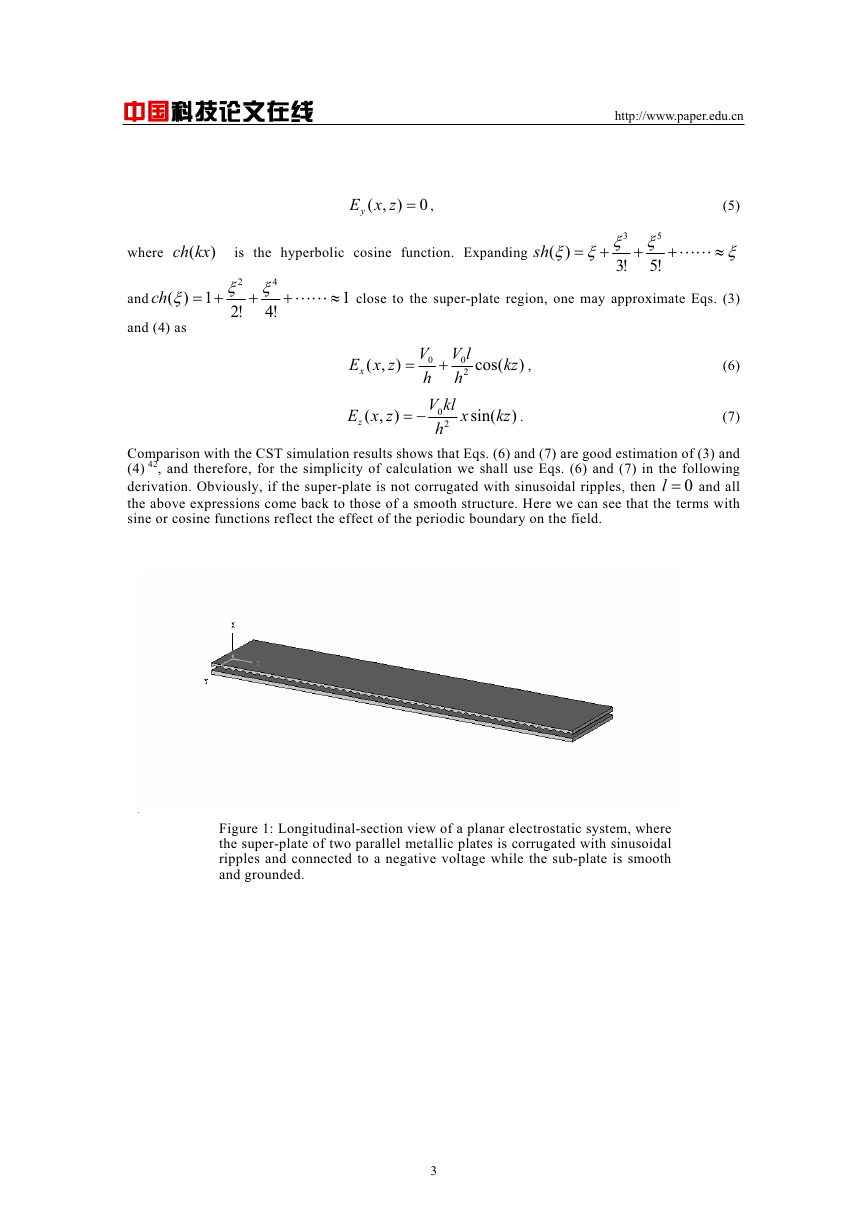
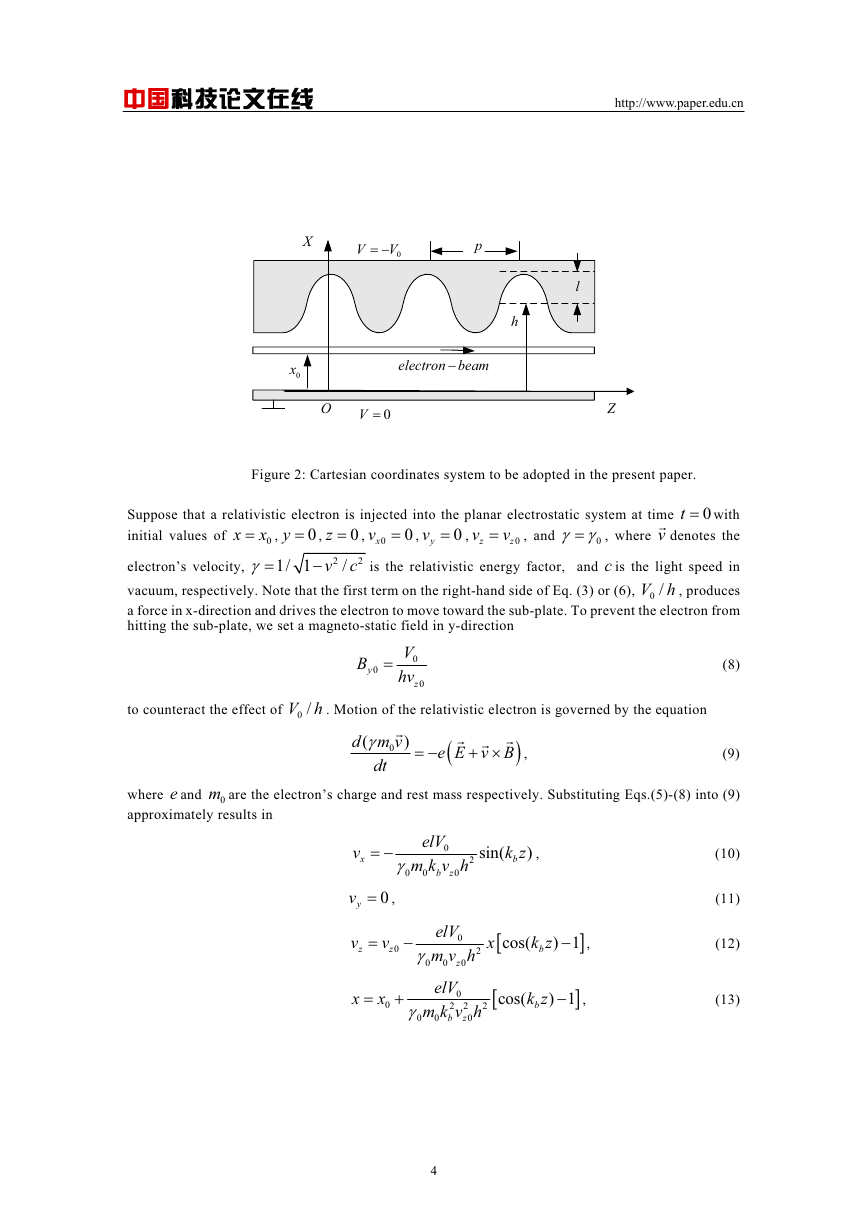

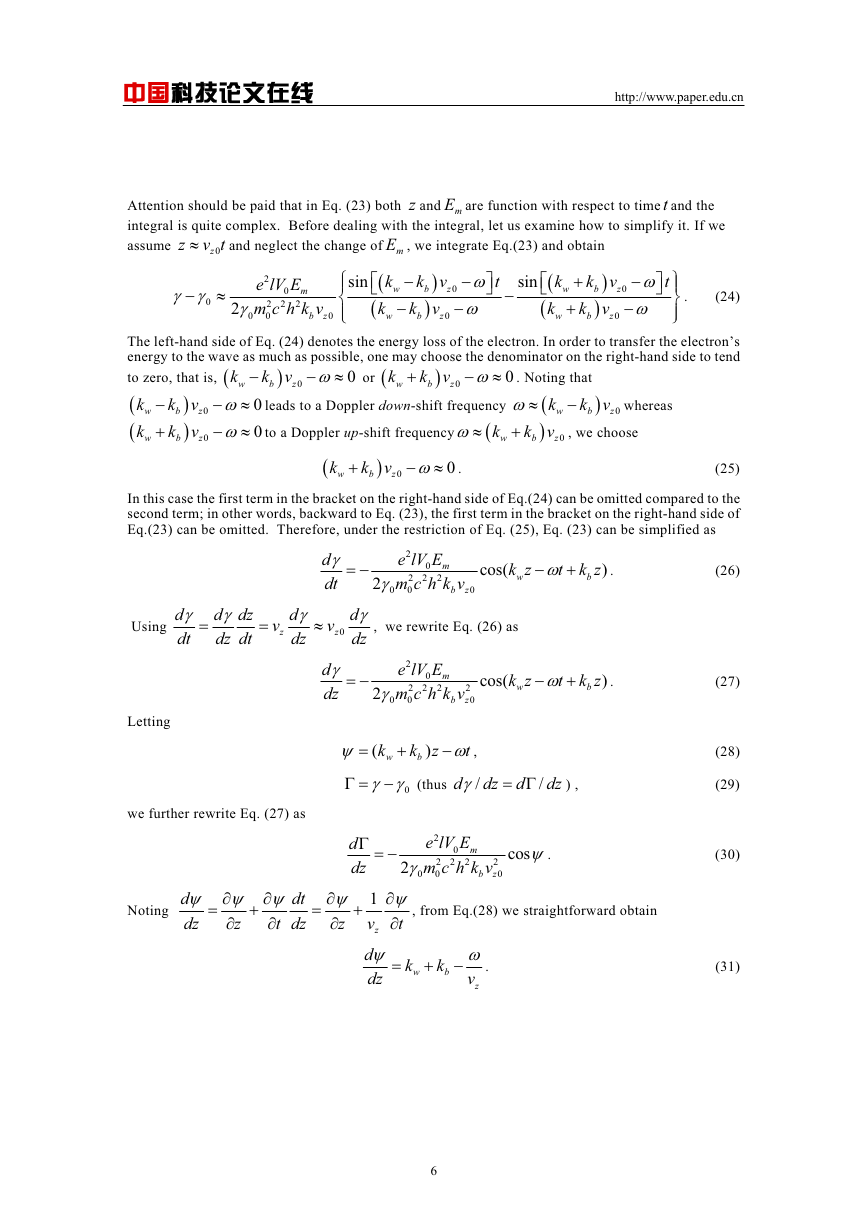
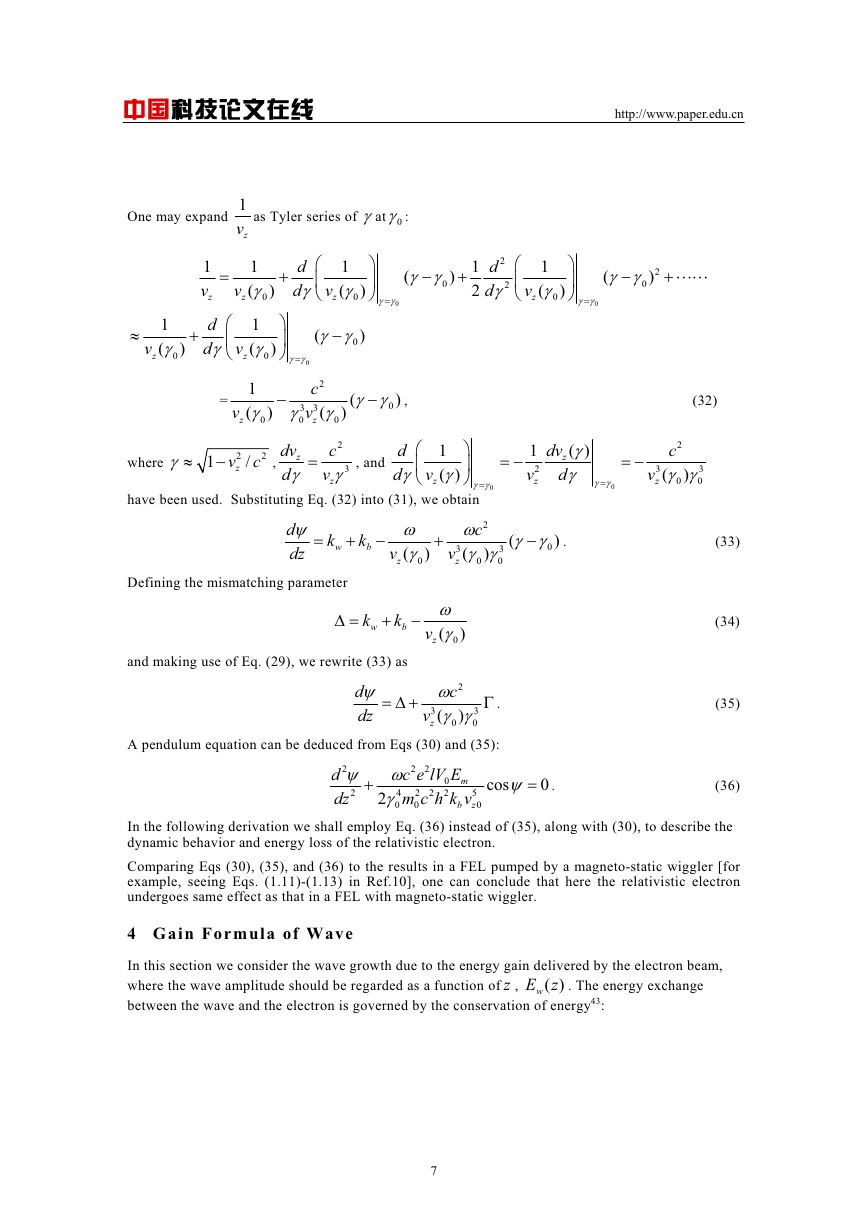
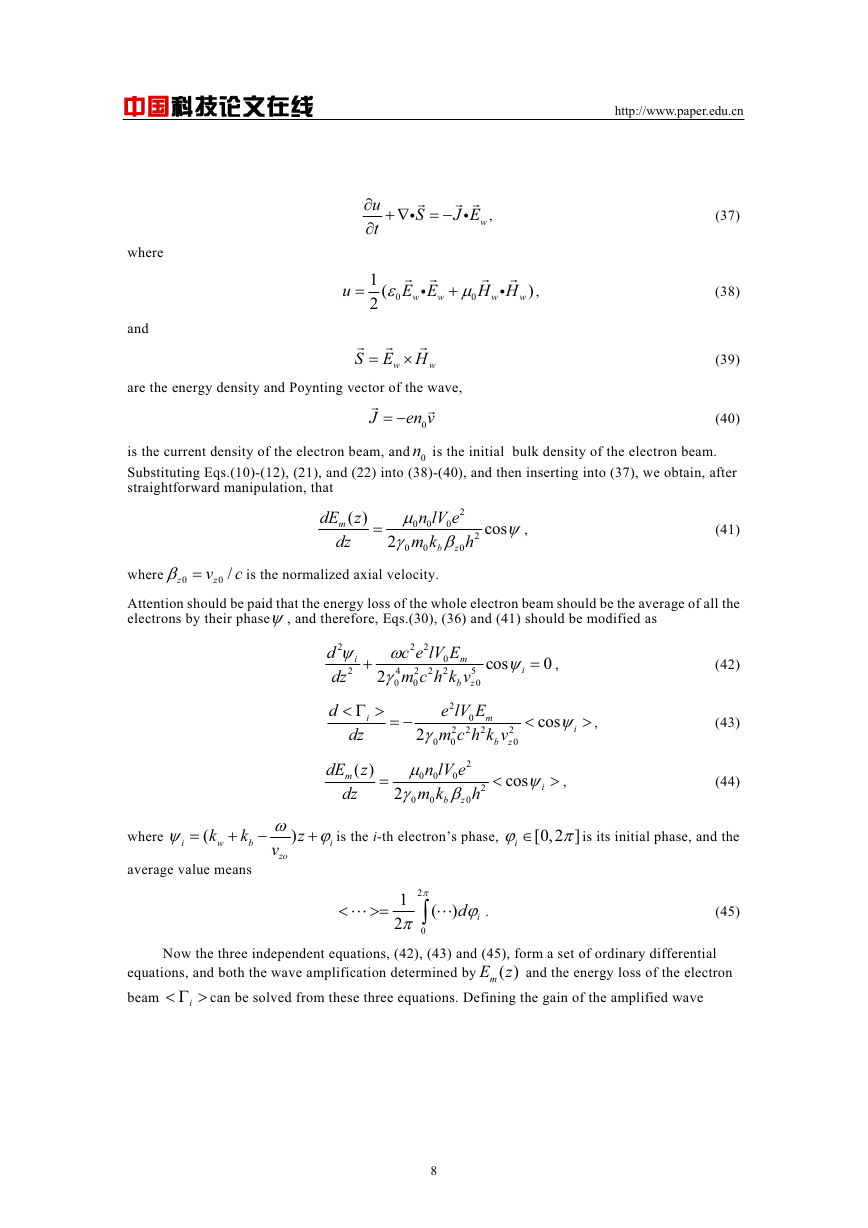








 2023年江西萍乡中考道德与法治真题及答案.doc
2023年江西萍乡中考道德与法治真题及答案.doc 2012年重庆南川中考生物真题及答案.doc
2012年重庆南川中考生物真题及答案.doc 2013年江西师范大学地理学综合及文艺理论基础考研真题.doc
2013年江西师范大学地理学综合及文艺理论基础考研真题.doc 2020年四川甘孜小升初语文真题及答案I卷.doc
2020年四川甘孜小升初语文真题及答案I卷.doc 2020年注册岩土工程师专业基础考试真题及答案.doc
2020年注册岩土工程师专业基础考试真题及答案.doc 2023-2024学年福建省厦门市九年级上学期数学月考试题及答案.doc
2023-2024学年福建省厦门市九年级上学期数学月考试题及答案.doc 2021-2022学年辽宁省沈阳市大东区九年级上学期语文期末试题及答案.doc
2021-2022学年辽宁省沈阳市大东区九年级上学期语文期末试题及答案.doc 2022-2023学年北京东城区初三第一学期物理期末试卷及答案.doc
2022-2023学年北京东城区初三第一学期物理期末试卷及答案.doc 2018上半年江西教师资格初中地理学科知识与教学能力真题及答案.doc
2018上半年江西教师资格初中地理学科知识与教学能力真题及答案.doc 2012年河北国家公务员申论考试真题及答案-省级.doc
2012年河北国家公务员申论考试真题及答案-省级.doc 2020-2021学年江苏省扬州市江都区邵樊片九年级上学期数学第一次质量检测试题及答案.doc
2020-2021学年江苏省扬州市江都区邵樊片九年级上学期数学第一次质量检测试题及答案.doc 2022下半年黑龙江教师资格证中学综合素质真题及答案.doc
2022下半年黑龙江教师资格证中学综合素质真题及答案.doc